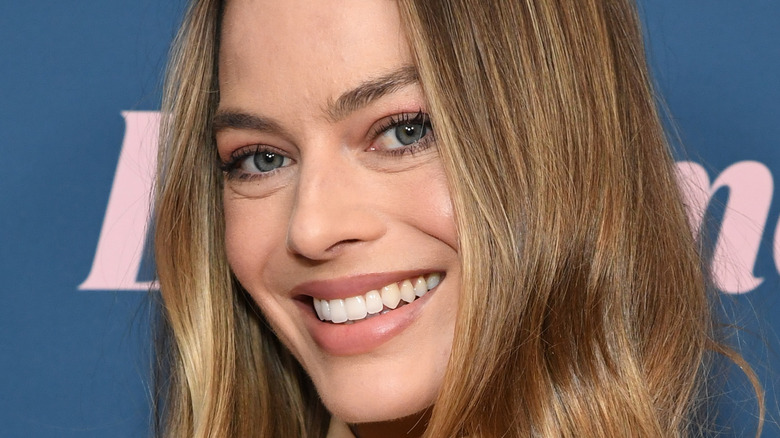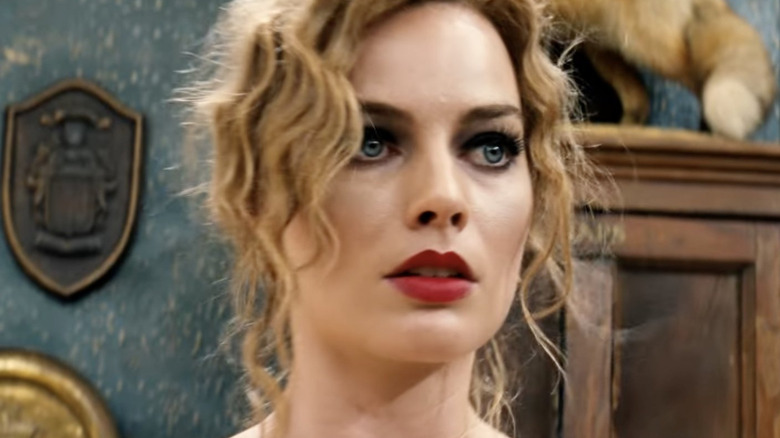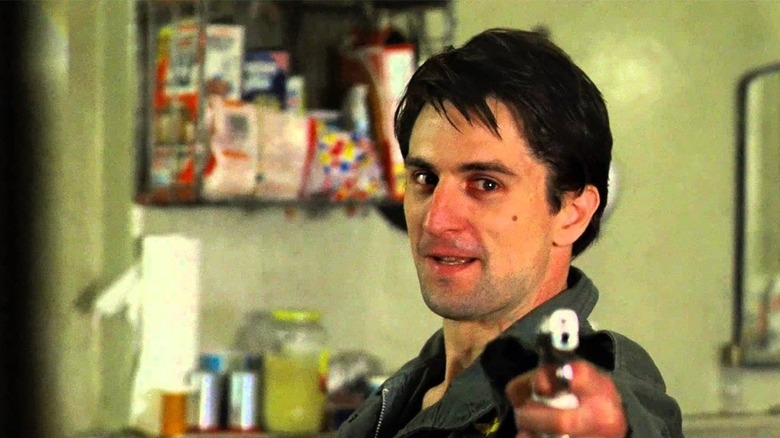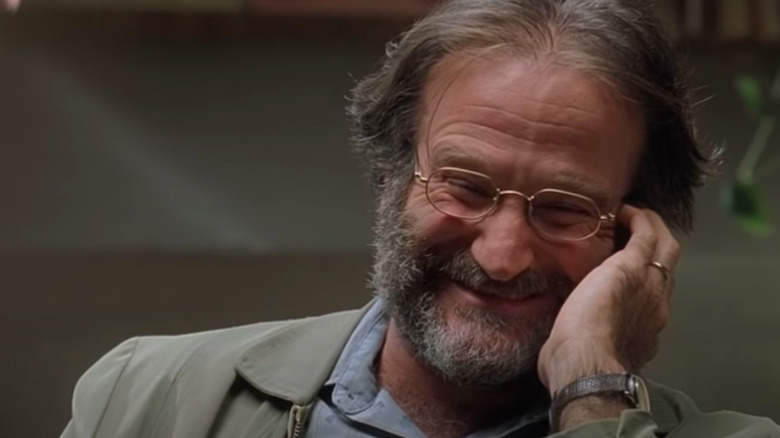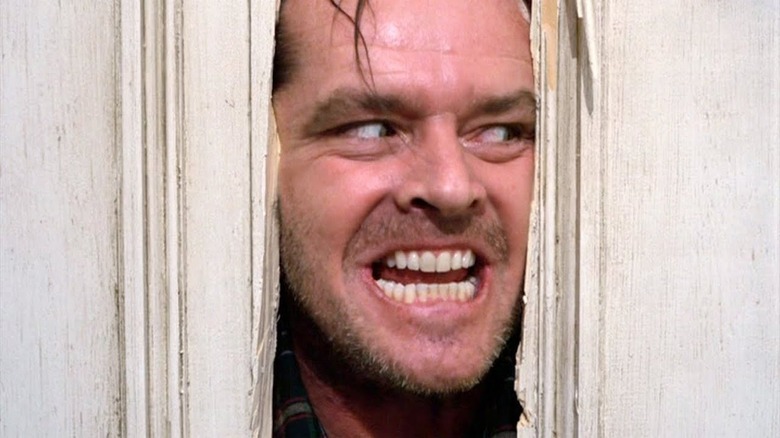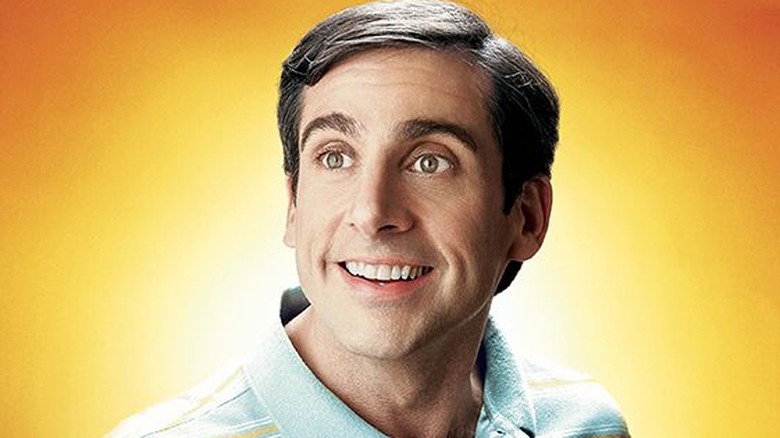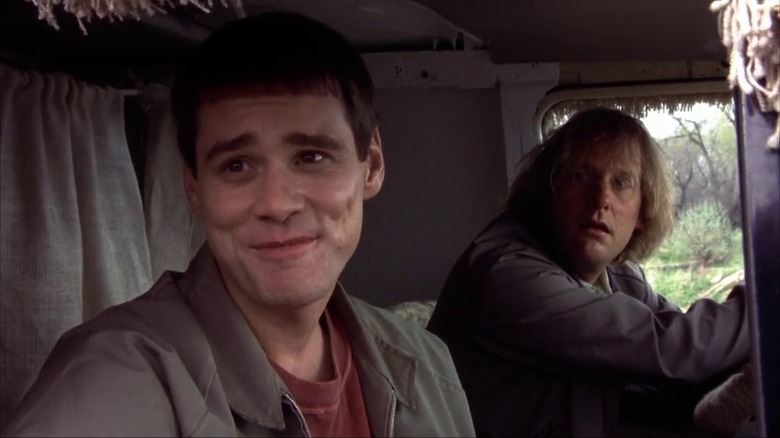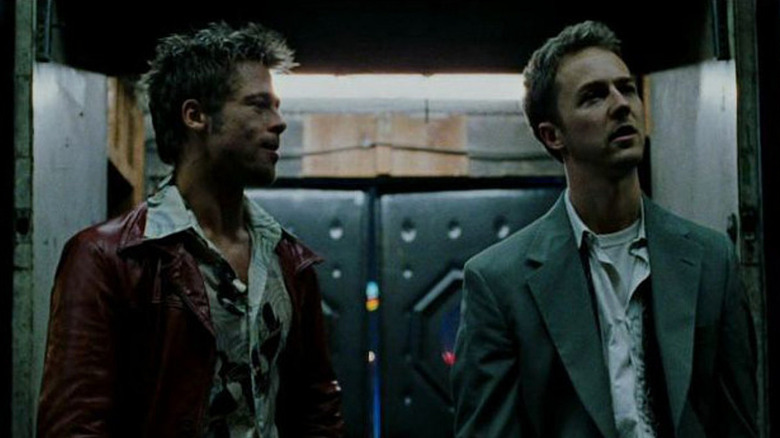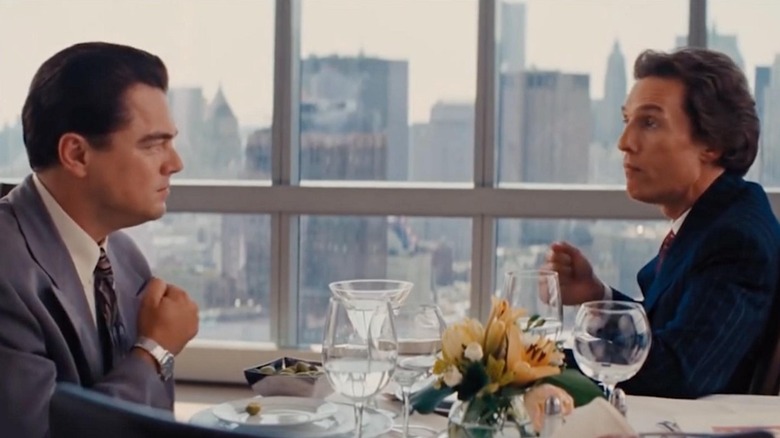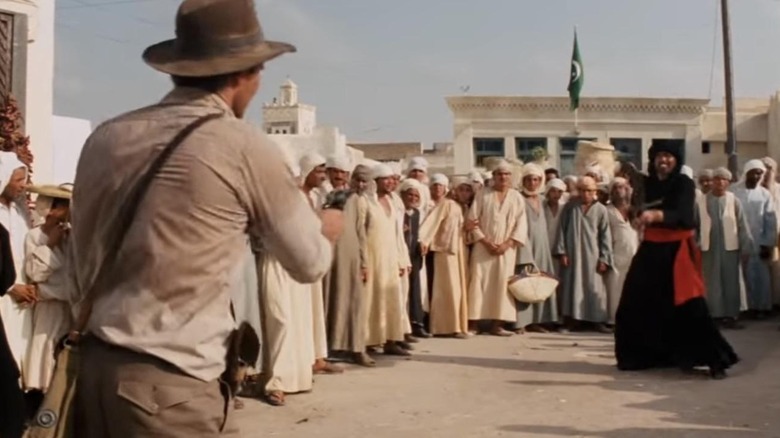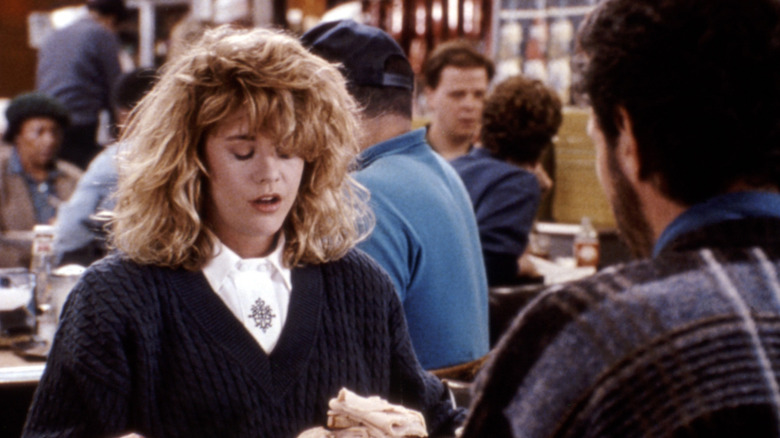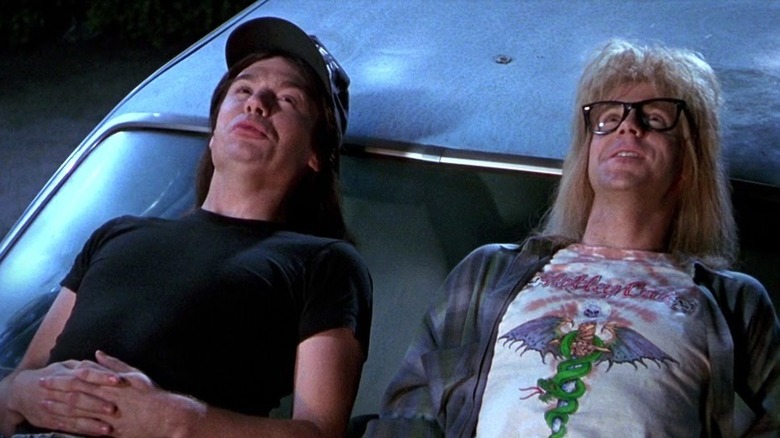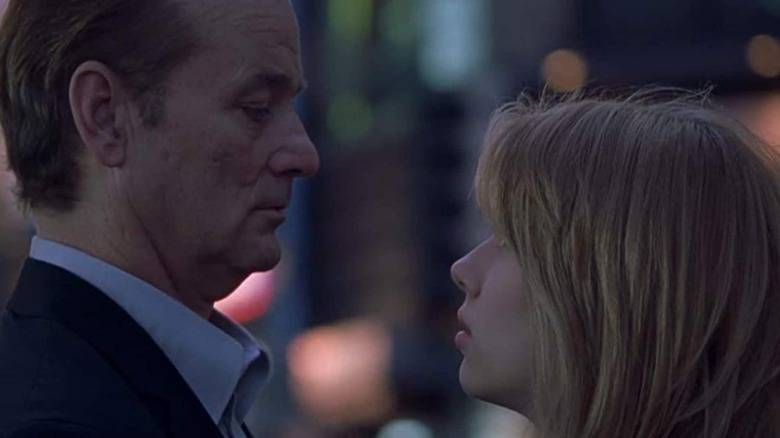Bizarre Reasons Actors Ditched The Script
To put it simply: if you don't have a screenplay, you don't have a film. The writing process is an integral part of pre-production, laying a foundation for the finished film that can be referenced by all facets of production. For auteurs and writer-directors, the screenplay is their first opportunity to explore their own vision for the movie. For hired directors, though, scripts are often mere starting points for what will eventually be their version of the story.
That being said, screenplays aren't bibles. It's often the case that scripts will go through vast changes up until the last minute, or even in the moment on set. Other times, directors will encourage their actors to improvise lines or go off-book in order to find some new and unexplored angles to the scene. Particularly for actors with comedic chops, having moments like these strengthen them as actors, and can often endear castmates to each other.
Let's take a look at some times when going off-script for a moment changed the course of the film. In some of these examples, iconic moments were made out of last-minute improvisations. In others, actors flexed their grasp on their own character through ad-libs or suggestions to the director. The art of filmmaking is a collaborative one, and these movies show that sometimes the best results come from all the stars aligning on the right day at the right time.
Margot Robbie doesn't miss her chance to kiss Brad Pitt
Damien Chazelle has had a short but illustrious career in Hollywood thus far. His first film, "Whiplash," garnered awards attention, but his follow-up movie musical "La La Land" was a critical darling, netting Emma Stone her Best Actress trophy. Though his Neil Armstrong biopic "First Man" underwhelmed audiences, 2022 found Chazelle aiming for a big comeback with "Babylon." The project features an ensemble of real movie stars playing an ensemble of fictional movie stars in a story set during a tumultuous, influential period of filmmaking.
Margot Robbie, as usual, embodies the heart of the film as Nellie LaRoy, a Hollywood star on the rise who heads down a dark and twisted path (via Vanity Fair). The role lets Robbie flex not only her charisma, but her unpredictability and affection for wild women (see her character-defining portrayal of Harley Quinn in 2020's "Birds of Prey"). Fortunately, Chazelle was the perfect director to allow her to embrace this character, but Robbie also found plenty of motivation from her co-star, Brad Pitt.
In an interview with E! News, Robbie described how her character ends up kissing Pitt's character in the film. On set, Robbie suggested it to Damien Chazelle as what her character would logically do. Even though Chazelle totally saw through Margot's ruse of just wanting to seize her opportunity to kiss Brad Pitt, he relented, and the moment made it into the final film.
Robert De Niro ad-libs to himself in the mirror
Robert De Niro has no need to prove himself these days; his career speaks for itself. The actor got his start in the 1970s, with films like "The Godfather Part II," "The Deer Hunter," and "Raging Bull." The latter film was one of his earliest collaborations with director Martin Scorsese, with whom he has since gone on to work with in films like "The King of Comedy," "Goodfellas," and most recently "The Irishman." The pair's extremely close working relationship, however, began in 1976 with the drama "Taxi Driver."
De Niro stars in the now-iconic role of Travis Bickle, a Vietnam veteran whose PTSD sends him spiraling mentally. One scene that's become a particular fixture in pop culture finds Travis practicing pulling a gun in the mirror. Deranged and trying to look tough, he repeats the phrase "You talkin' to me?" to himself, coining one of the most enduring lines in cinema history. Surprisingly, this moment was not in the original script written by Paul Schrader. As Scorsese and De Niro revealed on "Today," the scene was shot during the last week of filming, with only the director and actor in the room as De Niro improvised it.
Though the scene was ad-libbed, De Niro's inspiration for the line came much earlier than the day of shooting. There have been several sources cited as the impetus of the line (e.g. Marlon Brando's performance in "Reflections in a Golden Eye,"), but it allegedly originated from Bruce Springsteen, who coined it on-stage in the 1970s (per Variety).
Robin Williams gets Matt Damon to crack up
"Good Will Hunting" was a game-changer for the careers of Matt Damon and Ben Affleck. After they co-wrote the script together right out of college in the early 1990s, it was quickly optioned by producer Harvey Weinstein (via E! Online), who connected the two upstarts with a respected director, Gus Van Sant, as well as a genuine movie star in Robin Williams. The role was quite a departure for the long-time comedian, playing a widowed therapist who forms a father-son relationship with Damon's titular character Will, a genius janitor.
Though the script was originally written as a thriller, the suspense aspects were dropped as the movie focused on Will's relationship with Williams' character, Sean Maguire. Thankfully, the young writer-actors got their money's worth in having the legendary improviser in this muted, solemn role. In one scene, Williams went off-script and had his character tell an anecdote to Will about his wife farting in her sleep, causing Damon to burst out in hysterical laughter. Fans even noticed the shaking camera during the scene (per The Independent), proving that even the crew couldn't keep it together.
What's even more impressive about Williams' performance in this scene is how smoothly he transitions back into sincere, dramatic acting after the brief, hilarious moment, bringing life and nuance to the character. It's not even Williams' only improvisation that made it into the film; he also ad-libbed the film's final line, as Damon told GQ. Moments like these on set are likely the reason that Robin Williams won Best Supporting Actor for a role that changed the course of his career.
Jack Nicholson's Johnny Carson reference in The Shining
A quick Google search will help movie fans find one particular viral video that's circulated on the Internet for years (per The Irish Times). The behind-the-scenes footage, shot on the set of Stanley Kubrick's seminal 1980 film "The Shining," depicts Jack Nicholson psyching himself up for the iconic moment where he tears down a door with an axe, pokes his head through, and declares, "Here's Johnny!" It's one of the most memorable scenes in cinematic history, and has been referenced in pop culture hundreds of times.
However, it may surprise even diehard fans of "The Shining" that the line was in neither the script nor the original novel written by Stephen King, which Kubrick infamously adapted liberally into his horror classic. "The Shining" had a tumultuous production, to say the least, even setting the record for most amount of takes for a single scene (127, to be exact, for the scene where Nicholson intimidates Shelley Duvall on a staircase). The "Here's Johnny" scene in particular was shot over 60 times, meaning Nicholson tore through at least 60 doors in the process.
The iconic line, which was improvised by Nicholson on the spot, is a reference to Johnny Carson's introduction on "The Tonight Show" by Ed McMahon. Kubrick was oblivious to the reference, nearly leaving it on the cutting room floor, but ultimately it made the final cut. It's a mystery what other references Nicholson may have improvised for the other 59 takes.
Steve Carell gets his chest waxed
With "The 40-Year-Old Virgin" — arriving just as "The Office" was taking off — Steve Carell made the transition from "The Daily Show" correspondent to bona fide movie star. The film, which was directed by Judd Apatow, featured primarily improvised dialogue courtesy of its comedic cast (per Project Casting), which also included Seth Rogen, Paul Rudd, and Catherine Keener. One scene in particular, however, really showcased Carell's improvisational skills, because unlike other scenes in the film, his reactions were entirely real.
The scene, which happens during the first half of the film, finds Carell's introverted character Andy getting signed up by his friends for a chest waxing prior to a date. During the scene, Carell's real chest hair was actually waxed by a professional, causing him severe and excruciating pain on-camera (via The AV Club). Notably, one of Carell's most memorable exclamations during the scene was "Kelly Clarkson!" referencing the singer who won the first season of "American Idol" in 2002.
Despite the improvisational, mostly off-book production of the film, the reference to Clarkson wasn't exactly off the top of Carell's head. During a visit to Clarkson's talk show in 2020 (via CinemaBlend), Apatow spoke about the line's origin, citing a paper with a list of curses Carell could shout during the scene. One of them, snuck in by Seth Rogen, was the "American Idol" star's name, which ended up making its way into the film.
Jim Carrey goes even dumber in Dumb and Dumber
Jim Carrey was the king of studio comedies throughout the 1990s. His breakout role came with 1994's "Ace Ventura: Pet Detective," which he quickly followed up with "Liar Liar," "The Mask," and "Batman Forever" all within a few years. '94 also found him starring in "Dumb and Dumber," a Peter Farrelly movie where he co-starred with Jeff Daniels as one of two dimwitted friends. Coming hot on the heels of "Ace Ventura," the film was a career-maker for Carrey, and also helped establish a comedic career for Jeff Daniels, who at that point was known for his dramatic work.
Naturally, a film about two not-very-smart people is ripe with comedic potential. Carrey and Daniels star as Lloyd and Harry, who embark on a cross-country road trip to return a briefcase filled with ransom money to a woman who had left it for her husband's kidnappers. What ensues is a barrage of slapstick moments, including one scene where Lloyd and Harry naively pick up a hitchhiker who is actually one of the kidnappers himself. The antics that ensue throughout the scene are all the work of Carrey and Daniels improvising.
At one point, Carrey asks the kidnapper, played by Mike Starr, if he wants to hear "the most annoying sound in the world," and then proceeds to make a horrid screeching noise. As Jeff Daniels revealed to GQ, the off-script moment even visibly made him break character right before the scene cuts.
Edward Norton surprises Brad Pitt on camera
In 1999, David Fincher directed the film "Fight Club," starring Edward Norton and Brad Pitt as two strangers who start an underground fighting club that continues to grow in scale. The film has since become a cult hit, though at the time of its release it was subject to controversy and criticism (via Radio Times). For Norton and Pitt, however, "Fight Club" offered them career-defining roles as — spoiler alert — alter-egos of the same person.
Even 20 years after the movie's release, however, Edward Norton could still recall the close connection he and Pitt developed on the set of the movie. During a 2019 interview on "The Tonight Show with Jimmy Fallon," Norton offered a behind-the-scenes tidbit about the movie's first fight scene, which takes place outside a bar between the two characters. Fincher, wanting the actors to connect, suggested to Norton that he actually punch Pitt somewhere he wasn't expecting. Norton proceeded to, on camera, sock Brad Pitt in the ear, which actually made it into the movie.
The reaction that follows from Pitt is entirely authentic, as both actor and character express confusion at getting punched in the ear of all places. Funnily enough, the random choice by Norton actually works with the film's story, as it's logical that a delusional man fighting himself would end up punching his own ear.
Matthew McConaughey teaches Leonardo DiCaprio his meditation technique
"The Wolf of Wall Street" is one of Martin Scorsese's more unique films. Released in 2013, it stars Leonardo DiCaprio as Jordan Belfort, a real-life New York City stockbroker whose business practices led to an FBI investigation. It features a star-studded cast, including Jonah Hill, Cristin Milioti, and Kyle Chandler, as well as a breakout performance from Margot Robbie. One of the film's most surprising scene-stealers, however, is Matthew McConaughey, who appears briefly in the film as Mark Hanna.
During a lunch scene in which Belfort is recruited into Hanna's firm, the future law-breaker gets his first taste of the world of stockbroking. Belfort is particularly entranced by a meditative chest-thumping that Hanna does during the start of their meeting, which he's later taught. Memorable as it is, the chest-thumping wasn't in the original script; in fact, the method is actually utilized by Matthew McConaughey on movie sets to concentrate and find his voice, using a different melody for each character he plays (via The Independent).
After seeing McConaughey do it on set, DiCaprio suggested they add it into the scene, even after they had all the shots they needed. Luckily, DiCaprio's suggestion paid off, as they ended up using it in the final film. The technique ended up catching on among the film's many fans, as McConaughey has cited it as one of the things people commonly do to him on the street (via LAD Bible).
Harrison Ford is too sick for a sword fight
In the 1970s and 80s, few actors were as cool as Harrison Ford. The actor was first recognized by mainstream audiences with "American Graffiti," before becoming a full-fledged movie star after his debut as Han Solo in the first "Star Wars." He continued to gain success with the subsequent episodes of the original "Star Wars" trilogy, as well as a role in "Apocalypse Now." However, Ford proved he wouldn't be defined by Han Solo in 1981, when he starred in "Raiders of the Lost Ark" as the now-iconic professor-turned-treasure-hunter Indiana Jones.
While Ford reprised his role as Indy in four additional movies (one of them being 2023's "The Dial of Destiny"), some of his coolest moments as the character came from "Raiders." For example, one moment in the film finds Indiana Jones and his sidekick/love interest Marion Ravenwood ambushed by Nazis in Cairo, Egypt. Attempting to rescue Marion, Jones is faced with a flamboyant mercenary brandishing a sword, whom he quickly dispatches with a gunshot in front of a spectating crowd.
Initially, the fight wasn't supposed to be this brief. As producer Frank Marshall told The Hollywood Reporter, production in Cairo had been taking longer than anticipated, meaning the filmmakers didn't have time to shoot a lengthy choreographed whip vs. sword fight. Additionally, Ford was under the weather, so they opted to instead replace the sequence with Indy using his pistol. It was the right call, as it's become one of the most iconic moments for the character.
Meg Ryan makes a scene at Katz's Delicatessen
"When Harry Met Sally..." was a defining film for the romantic comedy genre. It stars Billy Crystal and Meg Ryan as the titular characters, two strangers to agree to be friends in an attempt to prove that sex always gets in the way of male-female friendships (spoiler alert: it does, but they live happily ever after anyway). Given the film's subject matter, it naturally follows that there are plenty of scenes that examine the differences between how men and women approach relationships.
One of these scenes, which takes place at Katz's Delicatessen in New York City (via Wide Open Eats), finds Harry and Sally arguing over whether or not Harry can tell the difference between a real orgasm and a fake one. In a moment that's incredibly out-of-character, Sally loudly fakes an orgasm in the middle of the deli, drawing the attention of patrons and humiliating Harry. Once it's over and Sally resumes eating her sandwich, an old woman nearby sarcastically tells a waiter, "I'll have what she's having."
The scene has become an iconic moment in cinematic history, but it was born out of improvisation between the actors (via Entertainment Weekly). Meg Ryan was the one who suggested she fake an orgasm during the writing stage, while Crystal came up with the final button on set. The old woman who says the line, in fact, is director Rob Reiner's mother.
Wayne and Garth wrap their film with improv
"Wayne's World" originated as a sketch on "Saturday Night Live," starring Mike Myers and Dana Carvey as two metalheads hosting a public access TV show from Wayne's mom's basement. Directed by Penelope Spheeris and released in 1992, the big screen adaptation has remained the highest-grossing film based on an "SNL" sketch, and has become a mainstay of American pop culture, particularly with its use of the Queen song "Bohemian Rhapsody" in one early scene in the film (per Rolling Stone).
However, the real heart of the film comes from the comedic chemistry between Myers and Carvey, which carried the film to its final week of shooting. In a 25th anniversary retrospective with Entertainment Weekly, Spheeris cited the last scene they shot for the film, which featured Wayne and Garth sitting on the hood of a car near an airport. It was the end of a 30-day shooting schedule, with Myers and Carvey needing to return to New York and get back work at "SNL."
The result was a delirious energy and a scene entirely improvised by Myers and Carvey. At an Academy discussion panel, Myers and Carvey fondly recalled the moment when Garth asks Wayne earnestly, "Did you ever find Bugs Bunny attractive when he'd put on a dress and play a girl bunny?" To which Wayne replies, "No," then proceeds to break character as the two laugh hysterically. It's a rare moment in a film like "Wayne's World" that reminds audiences that Myers and Carvey were something special.
Bill Murray's secret moment with Scarlett Johansson
A "Saturday Night Live" veteran who got his start on the second season of NBC's late-night sketch series, Bill Murray went on to become one of the biggest comedy movie stars on the '80s and '90s, earning icon status with "Ghostbusters," "Caddyshack," "Groundhog Day," and "Scrooged." But he began shifting from blockbuster laugh riots to offbeat dramedies with projects like Tim Burton's "Ed Wood" and Wes Anderson's "Rushmore," and by the new millennium his career was in a new phase. In 2003, Murray starred in "Lost in Translation" from writer-director Sophia Coppola, who won an Oscar for Best Original Screenplay for the film. Murray earned an Oscar nomination for Best Actor for his performance, which went on to become one of his most acclaimed.
Murray stars in the film alongside Scarlett Johansson in one of her earliest roles, as a young woman who Murray's character befriends during a work trip to Tokyo. The two spend the whole movie orbiting around each other, bonding over the difficulties in their respective marriages without ever crossing the line into a physical relationship, save for a kiss they share at the end. The finale became a huge talking point in discussions about the film, particularly due to a moment where Murray's character whispers something in Johansson's ear that the audience doesn't get to hear.
According to Coppola (via Creative Screenwriting), the whisper was an unscripted improvisation by Bill Murray, who came up with it after the writer-director expressed dissatisfaction with her own dialogue. Just what his character is whispering has, since the film's release, become the subject of speculation and theories, but the actors and filmmakers agree it's best left as a secret between the two characters (per Vulture).
